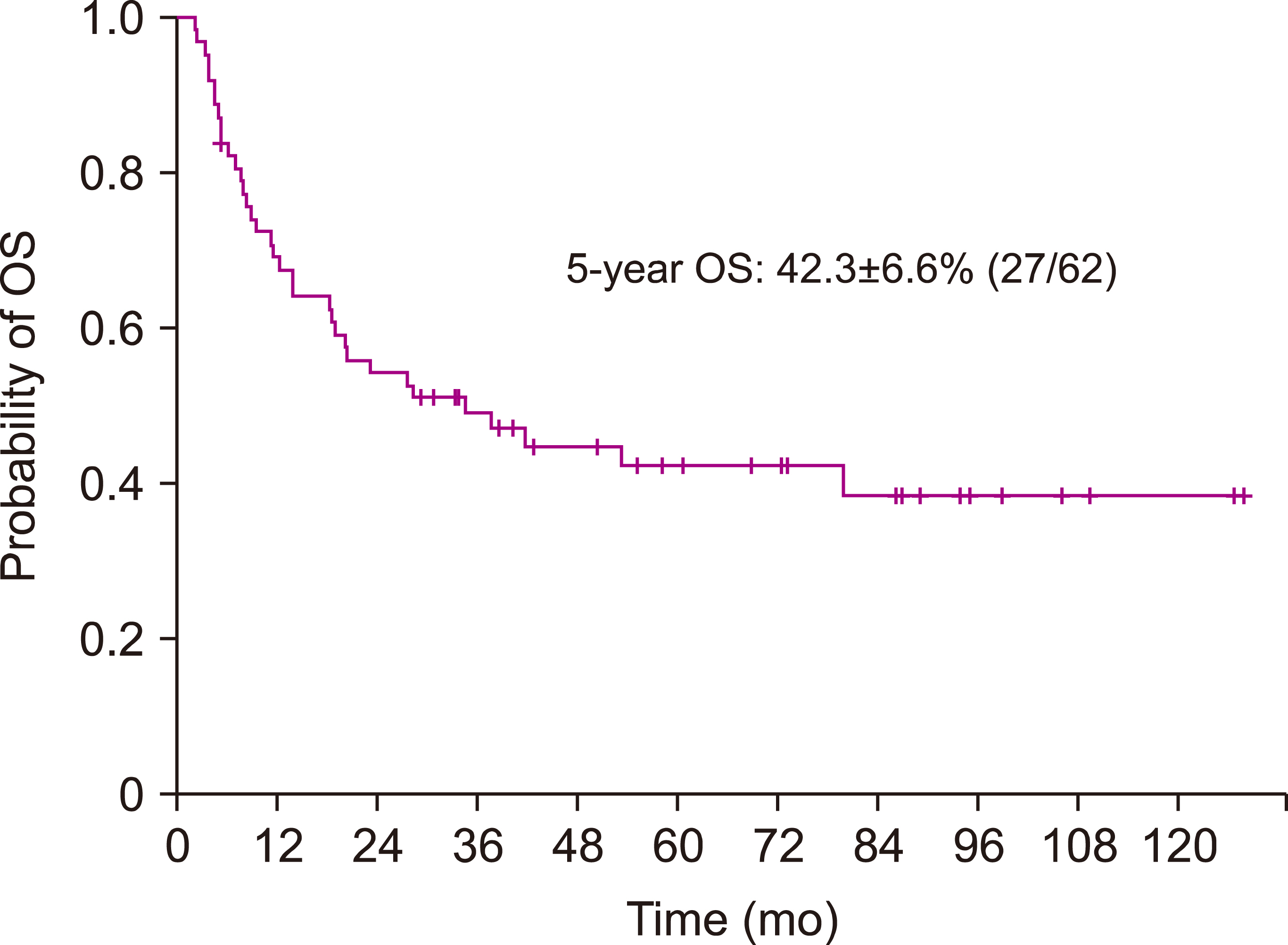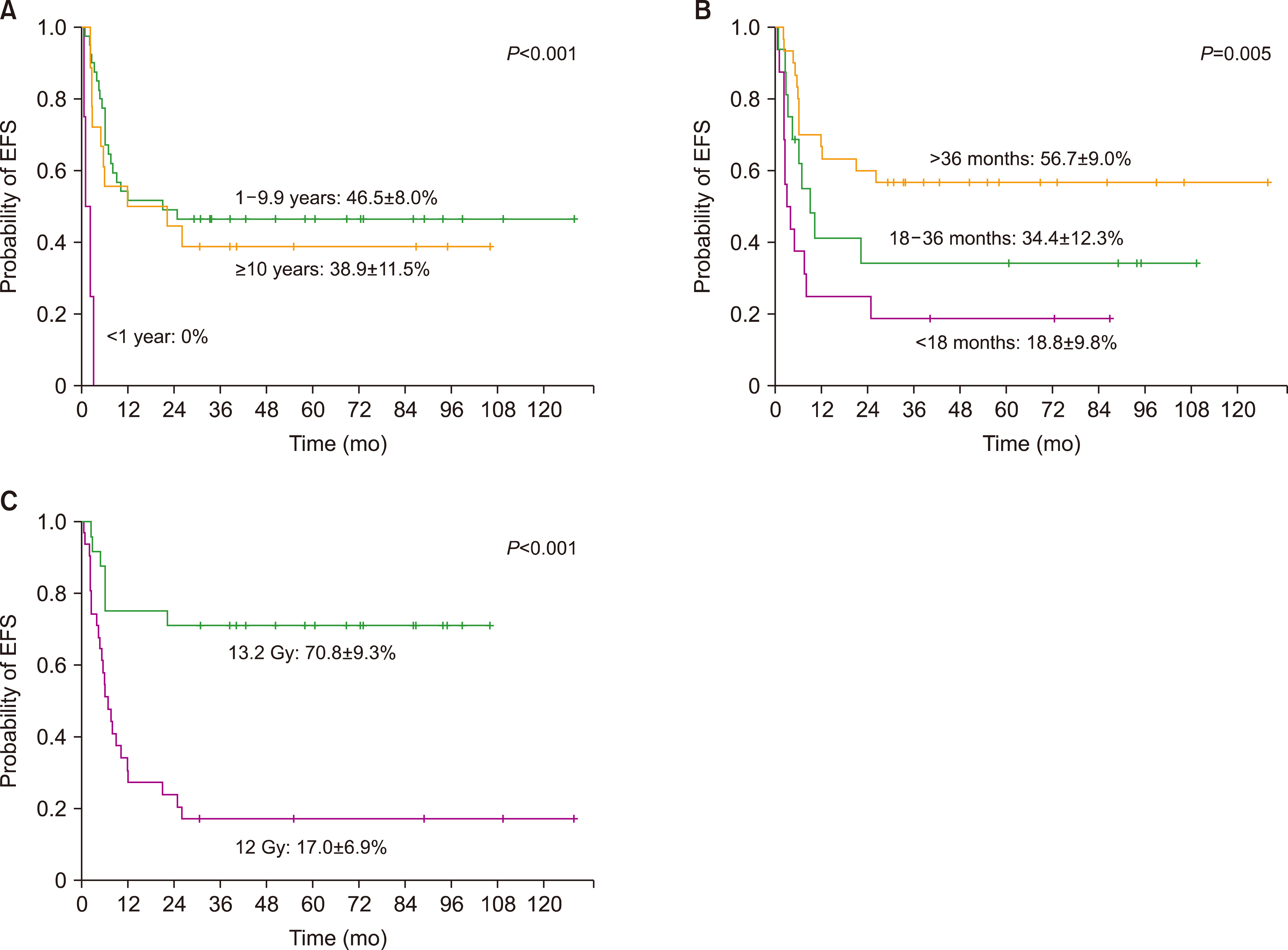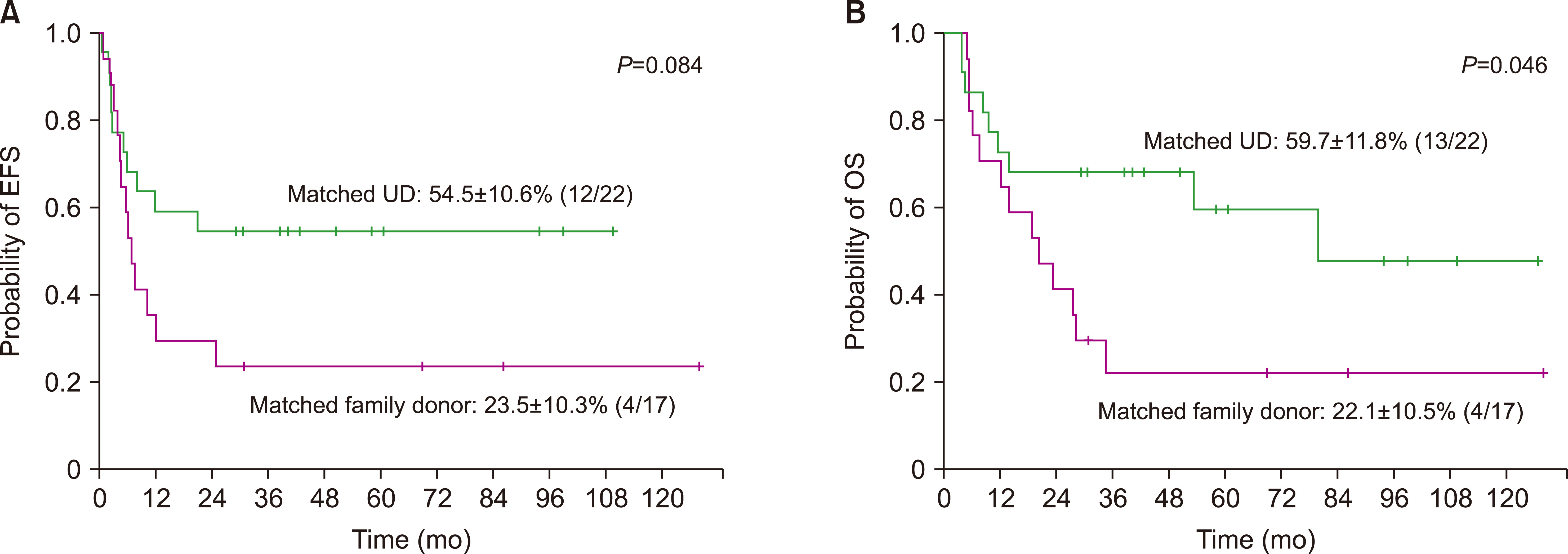Blood Res.
2022 Dec;57(4):256-263. 10.5045/br.2022.2022174.
Prognostic impact of total body irradiation dose in pediatric acute lymphoblastic leukemia patients treated with allogeneic hematopoietic stem cell transplantation in second complete remission
- Affiliations
-
- 1Division of Hematology and Oncology, Department of Pediatrics, College of Medicine, The Catholic University of Korea, Seoul, Korea
- KMID: 2537548
- DOI: http://doi.org/10.5045/br.2022.2022174
Abstract
- Background
Allogeneic HSCT may improve survival in pediatric ALL patients who relapse. In this study, we analyzed the outcome and prognostic factors of 62 ALL patients (35 male, 56.5%) who received allogeneic HSCT in second complete remission (CR) at our institution between April 1st 2009 and December 31st 2019.
Methods
The median time from diagnosis to relapse was 35.1 months (range, 6.0‒113.6 mo). Fifty-three patients (85.5%) experienced bone marrow relapse only. The number of patients who received transplant according to each donor type was as follows: HLA matched family donor 17 (27.4%), matched unrelated donor (UD) 22 (35.5%), mismatched donor 23 (37.1%). All patients received HSCT with a myeloablative conditioning, 58 patients (93.5%) with the incorporation of TBI [31 patients 12 Gray (Gy), 24 patients 13.2 Gy, 3 patients 8 Gy].
Results
The 5-year event-free survival (EFS), and overall survival of the study group was 41.3±6.3% (26/62), and 42.3±6.6% (27/62), respectively. The cumulative incidence of relapse and transplant-related mortality was 57.1±6.4% and 1.6±1.6%, respectively. Infant ALL, shorter time from diagnosis to relapse, and TBI dose of 12 Gy, rather than 13.2 Gy, resulted in significantly worse EFS. In multivariate analysis, infant ALL and TBI dose of 12 Gy during conditioning predicted significantly lower EFS.
Conclusion
In our study group, treatment with a higher dose of TBI during conditioning resulted in better EFS for ALL patients who underwent HSCT in second CR. Further study is needed to determine potential long-term complications associated with a higher TBI dose.
Keyword
Figure
Reference
-
1. Ward E, DeSantis C, Robbins A, Kohler B, Jemal A. 2014; Childhood and adolescent cancer statistics, 2014. CA Cancer J Clin. 64:83–103. DOI: 10.3322/caac.21219. PMID: 24488779.2. Malczewska M, Kośmider K, Bednarz K, Ostapińska K, Lejman M, Zawitkowska J. 2022; Recent advances in treatment options for childhood acute lymphoblastic leukemia. Cancers (Basel). 14:2021. DOI: 10.3390/cancers14082021. PMID: 35454927. PMCID: PMC9032060. PMID: 5e19730c94784a6c9c9fbb47a4904bfe.3. Leung AWK, Vincent L, Chiang AKS, et al. 2012; Prognosis and outcome of relapsed acute lymphoblastic leukemia: a Hong Kong Pediatric Hematology and Oncology Study Group report. Pediatr Blood Cancer. 59:454–60. DOI: 10.1002/pbc.24162. PMID: 22610685.4. Roy A, Cargill A, Love S, et al. 2005; Outcome after first relapse in childhood acute lymphoblastic leukaemia - lessons from the United Kingdom R2 trial. Br J Haematol. 130:67–75. DOI: 10.1111/j.1365-2141.2005.05572.x. PMID: 15982346.5. Nguyen K, Devidas M, Cheng SC, et al. 2008; Factors influencing survival after relapse from acute lymphoblastic leukemia: a Children's Oncology Group study. Leukemia. 22:2142–50. DOI: 10.1038/leu.2008.251. PMID: 18818707. PMCID: PMC2872117.6. Tallen G, Ratei R, Mann G, et al. 2010; Long-term outcome in children with relapsed acute lymphoblastic leukemia after time-point and site-of-relapse stratification and intensified short-course multidrug chemotherapy: results of trial ALL-REZ BFM 90. J Clin Oncol. 28:2339–47. DOI: 10.1200/JCO.2009.25.1983. PMID: 20385996.7. Algeri M, Merli P, Locatelli F, Pagliara D. 2021; The role of allogeneic hematopoietic stem cell transplantation in pediatric leukemia. J Clin Med. 10:3790. DOI: 10.3390/jcm10173790. PMID: 34501237. PMCID: PMC8432223. PMID: f9f53fe197454e1eb6ad545c983760aa.8. Davies SM, Ramsay NK, Klein JP, et al. 2000; Comparison of preparative regimens in transplants for children with acute lymphoblastic leukemia. J Clin Oncol. 18:340–7. DOI: 10.1200/JCO.2000.18.2.340. PMID: 10637248.9. Hill-Kayser CE, Plastaras JP, Tochner Z, Glatstein E. 2011; TBI during BM and SCT: review of the past, discussion of the present and consideration of future directions. Bone Marrow Transplant. 46:475–84. DOI: 10.1038/bmt.2010.280. PMID: 21113184.10. Tracey J, Zhang MJ, Thiel E, Sobocinski KA, Eapen M. 2013; Transplantation conditioning regimens and outcomes after allogeneic hematopoietic cell transplantation in children and adolescents with acute lymphoblastic leukemia. Biol Blood Marrow Transplant. 19:255–9. DOI: 10.1016/j.bbmt.2012.09.019. PMID: 23041605. PMCID: PMC3553255.11. Sabloff M, Chhabra S, Wang T, et al. 2019; Comparison of high doses of total body irradiation in myeloablative conditioning before hematopoietic cell transplantation. Biol Blood Marrow Transplant. 25:2398–407. DOI: 10.1016/j.bbmt.2019.08.012. PMID: 31473319. PMCID: PMC7304318.12. Lee EJ, Han JY, Lee JW, et al. 2012; Outcome of allogeneic hematopoietic stem cell transplantation for childhood acute lymphoblastic leukemia in second complete remission: a single institution study. Korean J Pediatr. 55:100–6. DOI: 10.3345/kjp.2012.55.3.100. PMID: 22474465. PMCID: PMC3315619.13. Locatelli F, Zecca M, Messina C, et al. 2002; Improvement over time in outcome for children with acute lymphoblastic leukemia in second remission given hematopoietic stem cell transplantation from unrelated donors. Leukemia. 16:2228–37. DOI: 10.1038/sj.leu.2402690. PMID: 12399966.14. Smith AR, Baker KS, Defor TE, Verneris MR, Wagner JE, Macmillan ML. 2009; Hematopoietic cell transplantation for children with acute lymphoblastic leukemia in second complete remission: similar outcomes in recipients of unrelated marrow and umbilical cord blood versus marrow from HLA matched sibling donors. Biol Blood Marrow Transplant. 15:1086–93. DOI: 10.1016/j.bbmt.2009.05.005. PMID: 19660721. PMCID: PMC5225985.15. Kennedy-Nasser AA, Bollard CM, Myers GD, et al. 2008; Comparable outcome of alternative donor and matched sibling donor hematopoietic stem cell transplant for children with acute lymphoblastic leukemia in first or second remission using alemtuzumab in a myeloablative conditioning regimen. Biol Blood Marrow Transplant. 14:1245–52. DOI: 10.1016/j.bbmt.2008.08.010. PMID: 18940679.16. Lee JW, Kim SK, Jang PS, et al. 2016; Treatment of children with acute lymphoblastic leukemia with risk group based intensification and omission of cranial irradiation: a Korean study of 295 patients. Pediatr Blood Cancer. 63:1966–73. DOI: 10.1002/pbc.26136. PMID: 27463364.17. Chung NG, Lee JW, Jang PS, Jeong DC, Cho B, Kim HK. 2013; Reduced dose cyclophosphamide, fludarabine and antithymocyte globulin for sibling and unrelated transplant of children with severe and very severe aplastic anemia. Pediatr Transplant. 17:387–93. DOI: 10.1111/petr.12073. PMID: 23551397.18. Kang HM, Kim SK, Lee JW, Chung NG, Cho B. 2021; Efficacy of low dose antithymocyte globulin on overall survival, relapse rate, and infectious complications following allogeneic peripheral blood stem cell transplantation for leukemia in children. Bone Marrow Transplant. 56:890–9. DOI: 10.1038/s41409-020-01121-9. PMID: 33199818.19. Przepiorka D, Weisdorf D, Martin P, et al. 1995; 1994 Consensus conference on acute GVHD grading. Bone Marrow Transplant. 15:825–8. PMID: 7581076.20. Jagasia MH, Greinix HT, Arora M, et al. 2015; National Institutes of Health consensus development project on criteria for clinical trials in chronic graft-versus-host disease: I. The 2014 Diagnosis and Staging Working Group Report. Biol Blood Marrow Transplant. 21:389–401. e1. DOI: 10.1016/j.bbmt.2014.12.001. PMID: 25529383. PMCID: PMC4329079.21. Peters C, Schrappe M, von Stackelberg A, et al. 2015; Stem-cell transplantation in children with acute lymphoblastic leukemia: a prospective international multicenter trial comparing sibling donors with matched unrelated donors-The ALL-SCT-BFM-2003 trial. J Clin Oncol. 33:1265–74. DOI: 10.1200/JCO.2014.58.9747. PMID: 25753432.22. Lee JW, Kim S, Jang PS, Chung NG, Cho B. 2021; Differing outcomes of patients with high hyperdiploidy and ETV6-RUNX1 rearrangement in Korean pediatric precursor B cell acute lymphoblastic leukemia. Cancer Res Treat. 53:567–75. DOI: 10.4143/crt.2020.507. PMID: 33070555. PMCID: PMC8053883.23. Oskarsson T, Söderhäll S, Arvidson J, et al. 2016; Relapsed childhood acute lymphoblastic leukemia in the Nordic countries: prognostic factors, treatment and outcome. Haematologica. 101:68–76. DOI: 10.3324/haematol.2015.131680. PMID: 26494838. PMCID: PMC4697893.24. Peters C, Dalle JH, Locatelli F, et al. 2021; Total body irradiation or chemotherapy conditioning in childhood ALL: a multinational, randomized, noninferiority phase III study. J Clin Oncol. 39:295–307. DOI: 10.1200/JCO.20.02529. PMID: 33332189. PMCID: PMC8078415.25. Friend BD, Bailey-Olson M, Melton A, et al. 2020; The impact of total body irradiation-based regimens on outcomes in children and young adults with acute lymphoblastic leukemia undergoing allogeneic hematopoietic stem cell transplantation. Pediatr Blood Cancer. 67:e28079. DOI: 10.1002/pbc.28079. PMID: 31724815.
- Full Text Links
- Actions
-
Cited
- CITED
-
- Close
- Share
- Similar articles
-
- Myeloablative Hematopoietic Stem Cell Transplantation with a Non-total Body Irradiation Regimen for Treating Pediatric Acute Lymphoblastic Leukemia
- Unusual isolated extramedullary relapse of acute lymphoblastic leukemia in the breast despite complete donor hematopoietic chimerism after allogeneic hematopoietic stem cell transplantation
- A Case of Ovarian-Relapse Sparing of the Marrow in a Patient with Acute T Cell Lymphoblastic Leukemia after Allogeneic Hematopoietic Stem Cell Transplantation
- Pediatric Allogeneic Hematopoietic Stem Cell Transplantation in Korea: April 2000: The Korean Society of Pediatric Hematology-Oncology
- Allogeneic Hematopoietic Stem Cell Transplantation Following Imatinib Plus Idarubicin and High-dose Cytarabine in Children with Philadelphia Chromosome-positive Acute Lymphoblastic Leukemia




